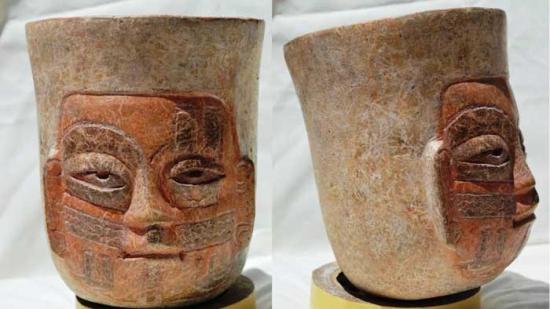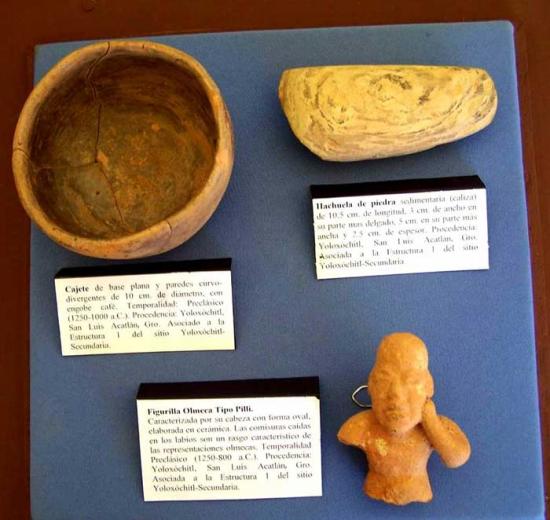Figurines provide clue to Olmec trading links in Mexico
Source - http://www.pasthorizonspr.com/index.php/archives/09/2014/figurines-provide-clue-to-olmec-trading-links-in-mexico?
Photos : INAH
IDENTIFICAN NUEVOS SITIOS DE FILIACIÓN OLMECA EN GUERRERO
Source - http://inah.gob.mx/boletin/2-actividades-academicas/7309-identifican-nuevos-sitios-de-filiacion-olmeca-en-guerrero

Hallazgo de figurilla olmeca. Arqueólogos del INAH identificaron ocho nuevos asentamientos de la ancestral cultura en Guerrero, con lo que suman 30 los registrados en esa entidad. Foto INAH
Specialists from the National Institute of Anthropology and History (INAH) in Mexico, have identified eight new sites where figurines, greenstone axes, jadeite, white ceramic bowls and gourds have been found. These sites are located in the Grande and Chica districts of the Guerrero coast (southwestern Mexico), and confirm an Olmec influence in that region.

Hallazgo de figurilla olmeca. A partir de la localización de vestigios, cuyo número de piezas asciende a medio centenar, se han podido determinar las posibles rutas comerciales de esta civilización. Foto INAH
There is ongoing debate as to whether the earliest peoples in this area were actual Olmec who had migrated, or an indigenous group who were heavily influenced by that culture, especially in the Mexcala River area. Olmec influence can certainly be seen in their cave paintings such as those found inJuxtlahuaca as well as stone tools and jade jewellery.
Eventually however, the peoples of the Mexcala River area developed their own distinctive culture, known as Mezcala or Mexcala, producing unique sculpture and ceramics, distinguished by its simplicity. Olmec influence did though remain in the villages by way of constructional techniques of the ceremonial centres and a government dominated by priests.
Olmec influence
X
Piezas encontradas en la última década en la zona guerrerense. Foto INAH
Over the past decade over 50 distinctive Olmec artefacts have been recovered which seems to point towards the possible trade routes, connecting Central Mexico to the Pacific Ocean.
The investigator, leading the team of specialists who created theArchaeological Atlas of Guerrero reported that Olmec material culture has now been located within the communities of San Marcos, San Luis Acatlán, Acapulco, Atoyac, Ometepe and Petatlán.

El hallazgo confirma la presencia olmeca en las costas Grande y Chica de Guerrero. Foto INAHH
“We know that there was a Pre-Olmeca (1300 BC-1100 BC) stage that developed toward the Gulf Coast; later in the period Apogee-Olmeca (1100 BC-900 BC) present in the Gulf Coast and in the Basin of Mexico, while in the Epi-Olmec (900 BC-600 BC) it radiated out to much of Mesoamerica. “
Linear trade route
It now seems more likely that the people from Guerrero were on the fringes of the main Olmec regions of La Venta and Tres Zapotes (Tabasco), and were integrated via trade routes. This speaks of a macro-regional interaction from the Gulf to the Pacific.
The archaeologist said that “Guerrero is like a time capsule in which the features of the Olmec religion are preserved in many of the rituals that are still practised in the state, such as the cult of water, the hill, the caves and the jaguar. “

Figurillas Olmecas de Titiritero. Conforme aparecen nuevos datos se tiene un mejor panorama de cómo estaban organizados los pueblos con características olmecas. Foto INAH
A linear trade route was first proposed in the 20th century, but it was not until 2006 when archaeologists began to encounter the recognisable Olmec figurines in Costa Chica, indicating that all rivers, including the Nexpa and Santa Catarina, were being used as part of a redistribution centre of commerce and information. These small settlements were always situated near tributaries and low hills, so it is possible that there are many more Olmec sites in the region, suggested Pérez Negrete.
He added that the route went from the Highlands and Gulf Coast; linking Mexico with Central Oaxaca, Chiapas, Veracruz and Tabasco. The Olmecs appeared to be highly organised and controlled access to coastal resources. Later, the Aztecs followed the same routes as part of their trading network.

Hachas de piedra verde y otras figurillas también fueron encontradas durante la última década en las costas Grande y Chica de Guerrero, lo que confirma la presencia de olmecas en esa región del estado. Foto INAH